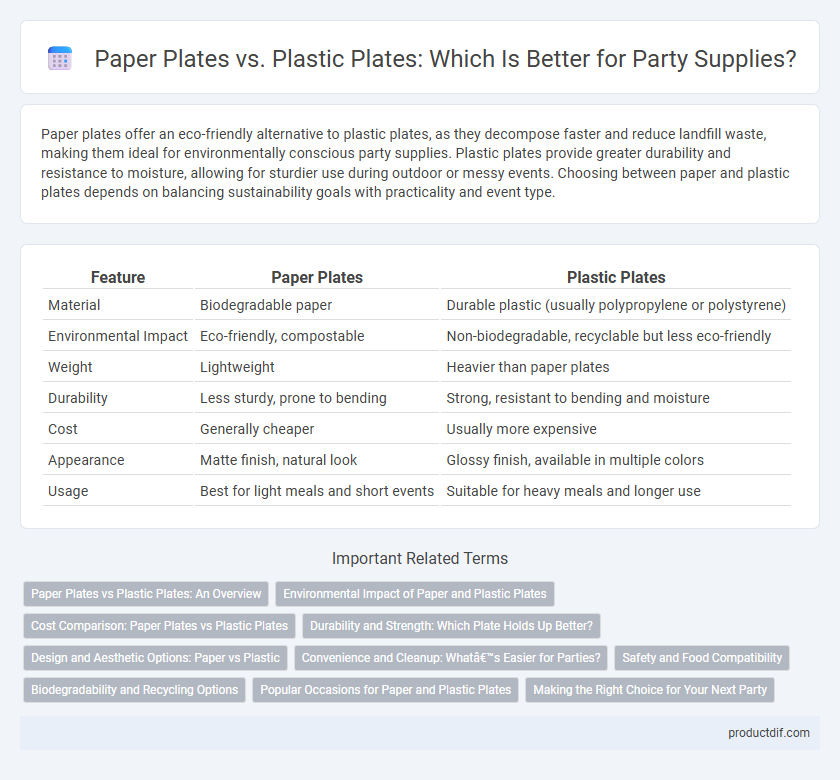Paper plates offer an eco-friendly alternative to plastic plates, as they decompose faster and reduce landfill waste, making them ideal for environmentally conscious party supplies. Plastic plates provide greater durability and resistance to moisture, allowing for sturdier use during outdoor or messy events. Choosing between paper and plastic plates depends on balancing sustainability goals with practicality and event type.
Table of Comparison
| Feature | Paper Plates | Plastic Plates |
|---|---|---|
| Material | Biodegradable paper | Durable plastic (usually polypropylene or polystyrene) |
| Environmental Impact | Eco-friendly, compostable | Non-biodegradable, recyclable but less eco-friendly |
| Weight | Lightweight | Heavier than paper plates |
| Durability | Less sturdy, prone to bending | Strong, resistant to bending and moisture |
| Cost | Generally cheaper | Usually more expensive |
| Appearance | Matte finish, natural look | Glossy finish, available in multiple colors |
| Usage | Best for light meals and short events | Suitable for heavy meals and longer use |
Paper Plates vs Plastic Plates: An Overview
Paper plates provide an eco-friendly alternative to plastic plates, offering biodegradability and ease of recycling, which reduces environmental impact. Plastic plates, often made from polystyrene or polypropylene, offer greater durability and are resistant to moisture and grease, making them suitable for heavier or liquid-based foods. Choosing between paper and plastic plates depends on factors such as event duration, food type, environmental concerns, and cost-effectiveness.
Environmental Impact of Paper and Plastic Plates
Paper plates decompose faster and are often compostable, reducing landfill waste compared to plastic plates, which can take hundreds of years to break down. Plastic plates contribute significantly to microplastic pollution, threatening marine ecosystems and wildlife. Choosing biodegradable paper plates made from recycled materials minimizes environmental harm and supports sustainable party practices.
Cost Comparison: Paper Plates vs Plastic Plates
Paper plates generally cost less upfront, making them a budget-friendly option for one-time events or large gatherings. Plastic plates have a higher initial price but can be reused multiple times, reducing cost per use over the long term. Considering party size and frequency helps determine whether the disposable affordability of paper plates or the durability and cost-efficiency of plastic plates provides better overall value.
Durability and Strength: Which Plate Holds Up Better?
Paper plates are typically designed for single use and tend to be less durable when holding heavy or saucy foods, often bending or becoming soggy. Plastic plates, especially those made from sturdier materials like melamine, offer superior strength and resistance to cracking under pressure, making them ideal for heavier meals. For parties where durability and reusability are priorities, plastic plates generally hold up better than paper plates.
Design and Aesthetic Options: Paper vs Plastic
Paper plates offer a wide range of vibrant designs and customizable prints that enhance themed party aesthetics, making them ideal for colorful and creative setups. Plastic plates provide a sleek, polished look with options for glossy finishes and durable textures, suitable for elegant or formal events. Both materials cater to diverse design preferences, but paper plates excel in versatile patterns while plastic plates emphasize reusability and refined style.
Convenience and Cleanup: What’s Easier for Parties?
Paper plates offer superior convenience and easier cleanup for parties due to their disposable nature, eliminating the need for washing. Plastic plates, while reusable and environmentally friendlier if chosen correctly, require washing and storage, which can be time-consuming and less practical for large gatherings. Disposable paper plates reduce post-party cleanup time significantly, making them the preferred choice for hassle-free entertaining.
Safety and Food Compatibility
Paper plates offer greater safety and food compatibility for party use due to their biodegradable nature and absence of harmful chemicals often found in plastic. Unlike plastic plates, they do not leach toxins when in contact with hot or acidic foods, reducing health risks. Paper plates are also less likely to cause allergic reactions, making them a safer choice for diverse guest groups.
Biodegradability and Recycling Options
Paper plates offer superior biodegradability, breaking down naturally within weeks, making them an eco-friendly choice for party supplies compared to plastic plates that can take hundreds of years to decompose. Recycling options for plastic plates are limited due to contamination from food residue and the types of plastic used, whereas many paper plates, especially those uncoated or compostable, can be recycled or composted effectively. Choosing biodegradable paper plates reduces landfill waste and supports sustainable party practices by leveraging renewable materials and promoting circular waste management.
Popular Occasions for Paper and Plastic Plates
Paper plates are popular for outdoor events like picnics, barbecues, and children's birthday parties due to their eco-friendly and disposable nature. Plastic plates are often preferred for formal gatherings, weddings, and holiday dinners because of their sturdiness and reusable options. Choosing between paper and plastic plates depends on the occasion's level of formality and environmental considerations.
Making the Right Choice for Your Next Party
Paper plates offer eco-friendly advantages with easy disposal and biodegradability, making them suitable for environmentally conscious events. Plastic plates provide durability and a polished appearance, ideal for formal gatherings or parties requiring sturdier serving ware. Selecting the right plate depends on the party's theme, guest preferences, and environmental considerations to ensure convenience and style.
Paper Plates vs Plastic Plates Infographic

 productdif.com
productdif.com